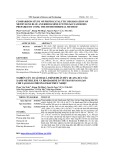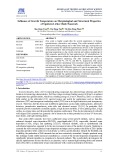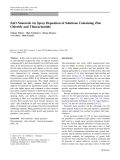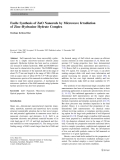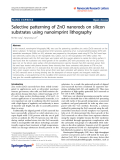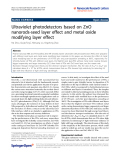
ZnO nanorods
-
In this study, we report on the hydrothermal synthesis of ZnO nanorods and the change in photocatalytic properties with different hydrothermal temperatures in the decomposition of Methylene blue (MB) and Rhodamine B (RhB) under visible light.
 11p
11p  viengfa
viengfa
 28-10-2024
28-10-2024
 2
2
 1
1
 Download
Download
-
Zinc oxide is highly sought after for several applications in biology, optoelectronics, electronics, and sensing. Zinc oxide nanorods exhibit a high exciton binding energy and a wide direct band gap, making them an attractive material for ultraviolet optoelectronic devices in the compound semiconductor field.
 6p
6p  viling
viling
 11-10-2024
11-10-2024
 4
4
 1
1
 Download
Download
-
Tuyển tập báo cáo các nghiên cứu khoa học quốc tế ngành hóa học dành cho các bạn yêu hóa học tham khảo đề tài: ZnO Nanorods via Spray Deposition of Solutions Containing Zinc Chloride and Thiocarbamide
 6p
6p  sting10
sting10
 07-03-2012
07-03-2012
 58
58
 6
6
 Download
Download
-
Tuyển tập báo cáo các nghiên cứu khoa học quốc tế ngành hóa học dành cho các bạn yêu hóa học tham khảo đề tài: Facile Synthesis of ZnO Nanorods by Microwave Irradiation of Zinc–Hydrazine Hydrate Complex Denthaje Krishna Bhat
 5p
5p  sting10
sting10
 24-02-2012
24-02-2012
 50
50
 7
7
 Download
Download
-
Tuyển tập báo cáo các nghiên cứu khoa học quốc tế ngành hóa học dành cho các bạn yêu hóa học tham khảo đề tài: Selective patterning of ZnO nanorods on silicon substrates using nanoimprint lithography
 11p
11p  sting05
sting05
 09-02-2012
09-02-2012
 43
43
 5
5
 Download
Download
-
Tuyển tập báo cáo các nghiên cứu khoa học quốc tế ngành hóa học dành cho các bạn yêu hóa học tham khảo đề tài: Ultraviolet photodetectors based on ZnO nanorods-seed layer effect and metal oxide modifying layer effect
 6p
6p  sting05
sting05
 09-02-2012
09-02-2012
 58
58
 6
6
 Download
Download
-
ITuyển tập báo cáo các nghiên cứu khoa học quốc tế ngành hóa học dành cho các bạn yêu hóa học tham khảo đề tài: nfluence of helium-ion bombardment on the optical properties of ZnO nanorods/p-GaN light emitting diodes
 13p
13p  dauphong6
dauphong6
 05-01-2012
05-01-2012
 60
60
 5
5
 Download
Download
CHỦ ĐỀ BẠN MUỐN TÌM








